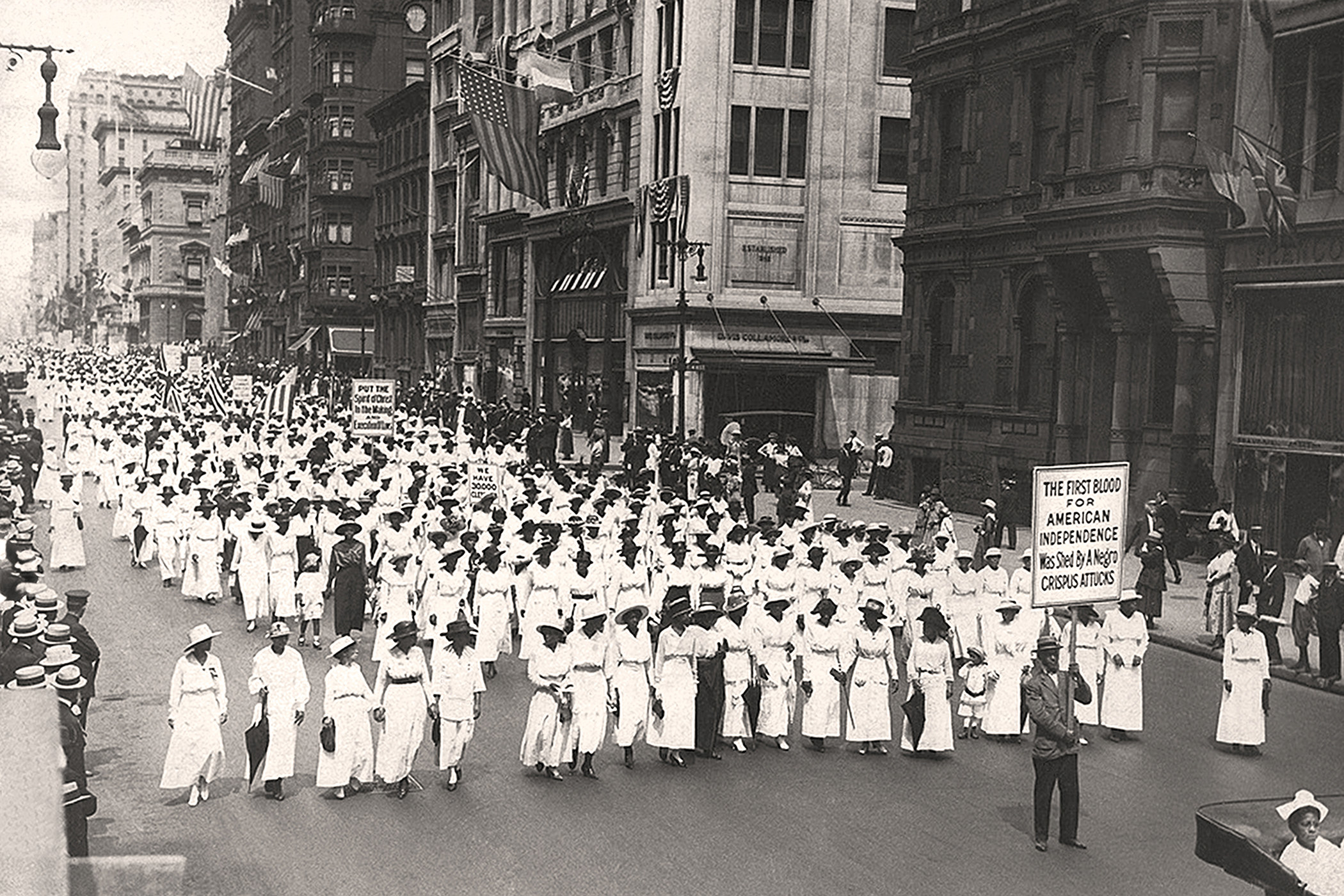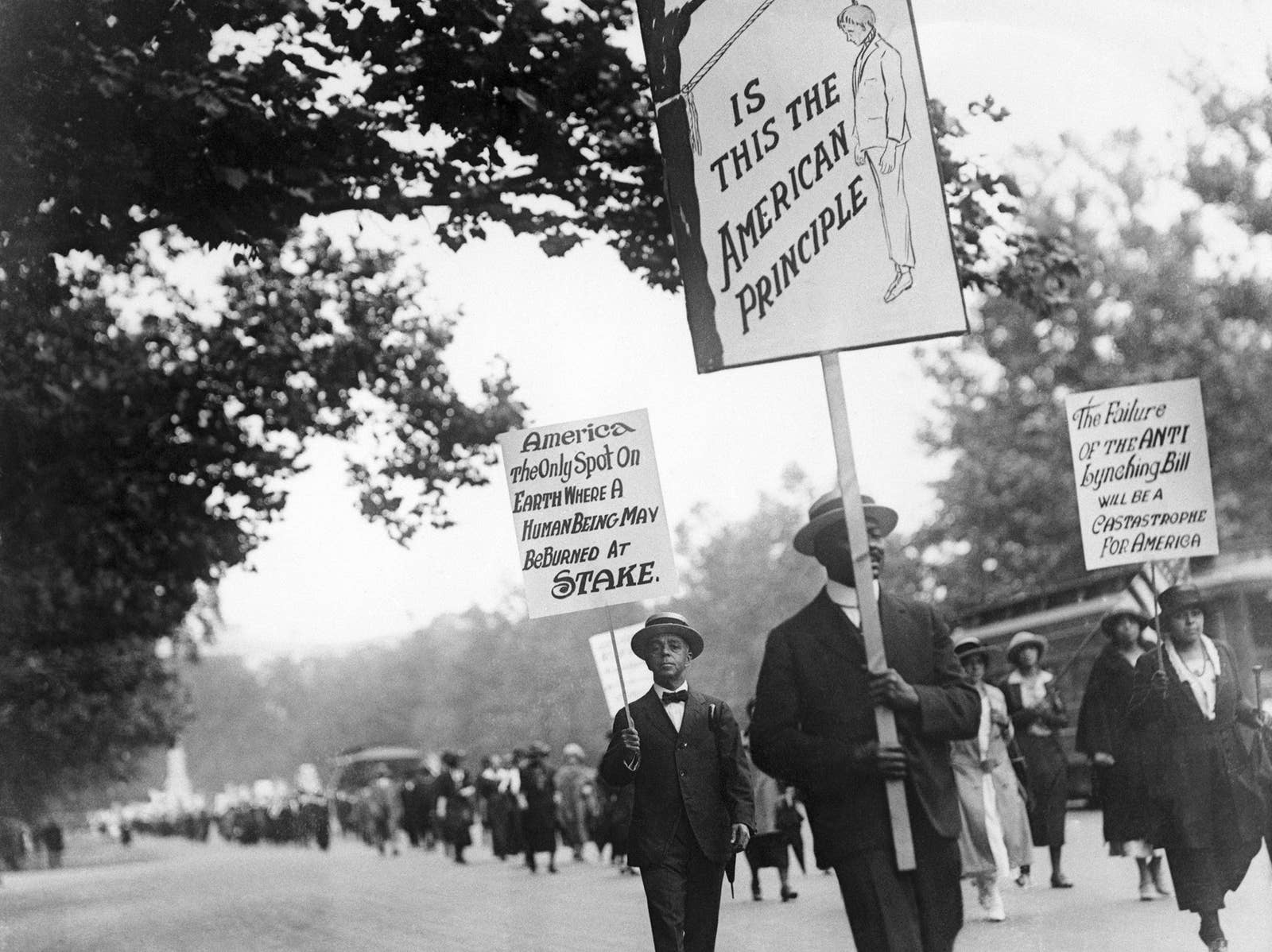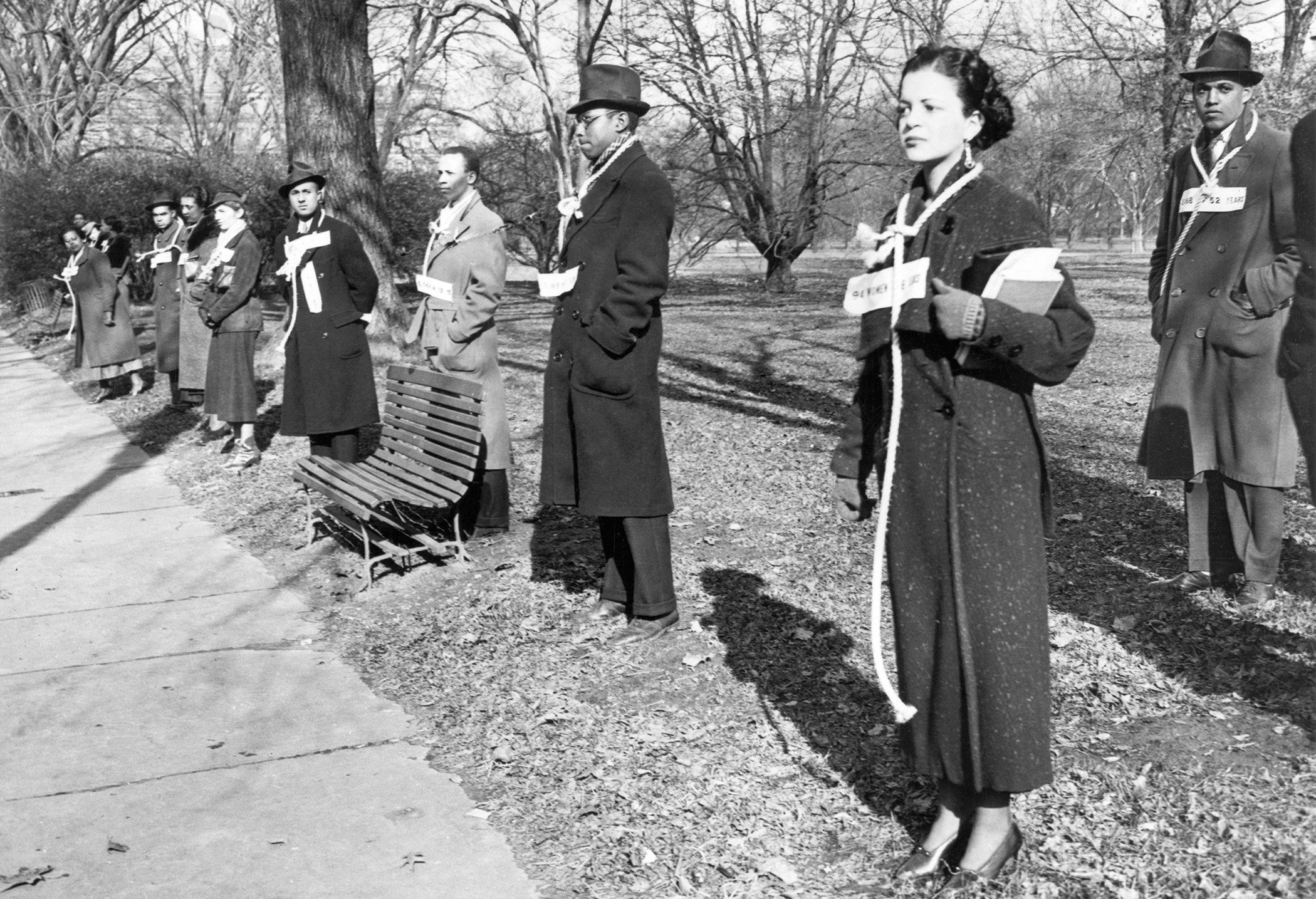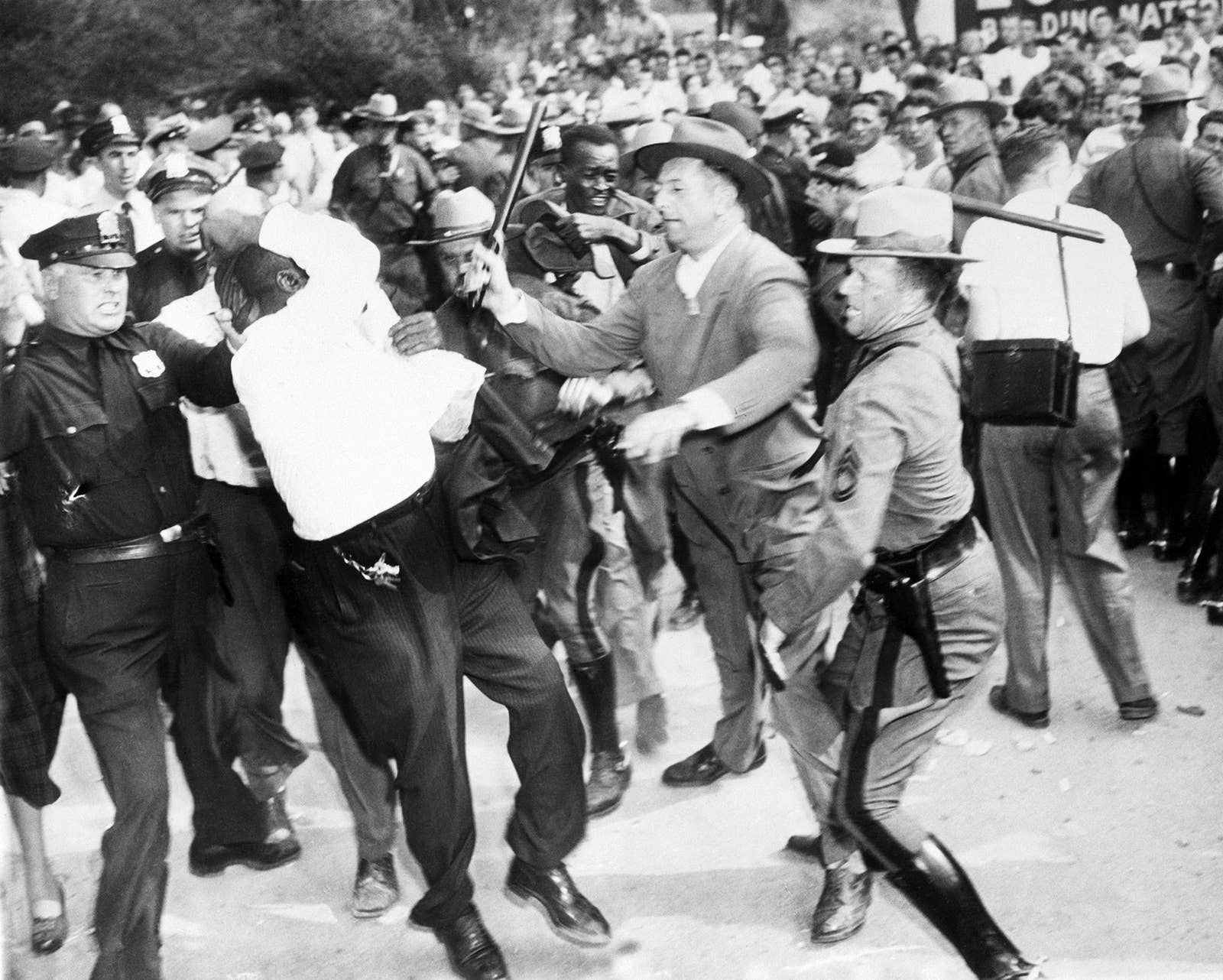RIGHT CLICK TO EXPAND PHOTOS
THE FIRST VICTIM OF BRITISH FIRE IN THE REVOLUTIONARY WAR
WAS CRISPUS ATTICUS A BLACK MAN.

ERIE
A silent march in New York City to protest the police treatment of Black people during riots in St. Louis, 1917. Thousands marched down Fifth Avenue without saying a word. They chanted no chants, sang no protest songs. The only sounds were the disconcertingly mournful thuds of muffled drums and, of course, the marchers' footsteps on the hot pavement. It was a parade of silent protest.

More than 3,000 people carried signs in Washington, DC, urging the end of lynching in America, 1922.

 State troopers beat a man leaving a concert by Paul Robeson at the Old Hollow Brook Golf Club in Cortlandt Manor, New York, Sept. 4, 1949. Troopers and police, who were supposed to protect concertgoers from anti-Robeson protesters, joined them in harassing them instead.
State troopers beat a man leaving a concert by Paul Robeson at the Old Hollow Brook Golf Club in Cortlandt Manor, New York, Sept. 4, 1949. Troopers and police, who were supposed to protect concertgoers from anti-Robeson protesters, joined them in harassing them instead.

ERIE
A silent march in New York City to protest the police treatment of Black people during riots in St. Louis, 1917. Thousands marched down Fifth Avenue without saying a word. They chanted no chants, sang no protest songs. The only sounds were the disconcertingly mournful thuds of muffled drums and, of course, the marchers' footsteps on the hot pavement. It was a parade of silent protest.

More than 3,000 people carried signs in Washington, DC, urging the end of lynching in America, 1922.

Protesters stand outside the Daughters of the American Revolution Museum with signs and nooses around their necks, Jan. 1, 1934.
This Is What 100 Years Of Protests For Racial Justice Looks Like In America
From the 1917 silent protests in the streets of Manhattan to the recent national unrest following the killing of George Floyd, these pictures capture the long and tumultuous struggle for racial justice in the US.
Gabriel H. SanchezSenior Photo Essay Editor
Posted on June 5, 2020, at 11:44 a.m. ET

As demonstrators across the US are raising their voices following the death of George Floyd, an unarmed Black man who was killed while in the custody of Minneapolis police, powerful images of these protests are circulating throughout the world. These photos can define a movement for years to come, and become the foundation from which future generations are able to frame their own struggles for civil liberties.
“Most Americans today learn about the Civil Rights Movement through photographs,” wrote historian Mark Speltz in Time following the 2016 shooting death of Alton Sterling by two white police officers in Baton Rouge, Louisiana. “Photographs from modern America’s defining social justice struggle are critical touchstones in the visual narrative of our nation’s past.”
The struggle for civil rights has a long visual history. For the sake of simplicity, we focused on the past 100 years, starting with 1917 when thousands of protesters took to the streets of Manhattan in mournful silence, in response to the East St. Louis race riots, which killed dozens of Black people and left thousands more homeless.
A century later, and in stark contrast to the silent protest of 1917, are the photographs captured in the days after Michael Brown was shot and killed by a white police officer in Ferguson, Missouri in 2014. There, demonstrators were met with severe force, reminiscent of the major flashpoints of the civil rights era in the 1960s — moments like the March on Washington in 1963 and the Selma to Montgomery marches in 1965. Those pictures are seared into our collective memory and offer a visual roadmap of what has been accomplished and what is left to be done.
From the 1917 silent protests in the streets of Manhattan to the recent national unrest following the killing of George Floyd, these pictures capture the long and tumultuous struggle for racial justice in the US.
Gabriel H. SanchezSenior Photo Essay Editor
Posted on June 5, 2020, at 11:44 a.m. ET

As demonstrators across the US are raising their voices following the death of George Floyd, an unarmed Black man who was killed while in the custody of Minneapolis police, powerful images of these protests are circulating throughout the world. These photos can define a movement for years to come, and become the foundation from which future generations are able to frame their own struggles for civil liberties.
“Most Americans today learn about the Civil Rights Movement through photographs,” wrote historian Mark Speltz in Time following the 2016 shooting death of Alton Sterling by two white police officers in Baton Rouge, Louisiana. “Photographs from modern America’s defining social justice struggle are critical touchstones in the visual narrative of our nation’s past.”
The struggle for civil rights has a long visual history. For the sake of simplicity, we focused on the past 100 years, starting with 1917 when thousands of protesters took to the streets of Manhattan in mournful silence, in response to the East St. Louis race riots, which killed dozens of Black people and left thousands more homeless.
A century later, and in stark contrast to the silent protest of 1917, are the photographs captured in the days after Michael Brown was shot and killed by a white police officer in Ferguson, Missouri in 2014. There, demonstrators were met with severe force, reminiscent of the major flashpoints of the civil rights era in the 1960s — moments like the March on Washington in 1963 and the Selma to Montgomery marches in 1965. Those pictures are seared into our collective memory and offer a visual roadmap of what has been accomplished and what is left to be done.
These images also reveal how little has changed in the decades since. “Despite the distance of the decades,” Speltz wrote in 2016, “the moving imagery of the emerging Black Lives Matter movement builds upon a visual narrative of protest and struggle that remains all too relevant in the present.”
These pictures chronicle over one century of protests for racial justice in America

Extract from Mining Review 2nd Year No. 11 (1949)
The highlight of this 1949 issue is the visit of American actor and singer Paul Robeson to Woolmet Colliery near Edinburgh. Robeson was also a renowned (and often persecuted) left-wing political activist and he made several visits to British mining communities. On this occasion he sings "I Dreamed I Saw Joe Hill Last Night" for miners in the canteen, a song about an American trade unionist who was allegedly framed on a murder charge and executed in 1915. Robeson had long been something of a hero to the British mining community, ever since he starred in the film Proud Valley (d. Pen Tennyson, 1940) as an American sailor stranded in Cardiff who finds work in a Welsh colliery (the newsreel opens with a short clip from the film).
SEE THE REST OF THE PHOTO'S HERE
No comments:
Post a Comment